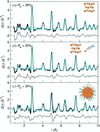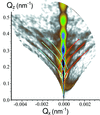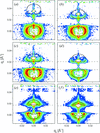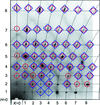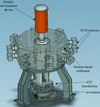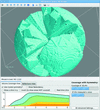issue contents
April 2011 issue

Cover illustration: Selected images of optical birefringence recorded during the heating of dodecasil-3C crystals. Courtesy of Lethbridge et al. [J. Appl. Cryst. (2010), 43, 168-175].
research papers
Spherical symmetry is a frequent assumption when the structure factor is used for data analysis of small-angle scattering data. The present article suggests a correction which may be used for non-spherical scatterers at low volume fractions.
A post-processing method for X-ray diffraction computed microtomography analysis of complex materials is presented. The paper shows the potential of the method in constructing three-dimensional quantitative maps of the individual solid phases present in hydrating cement pastes.
How to test and verify the required linearity of X-ray detectors is discussed for a wide range of crystallographic and X-ray measurements.
Download citation


Download citation


In situ synchrotron powder X-ray diffraction is used to study the formation of LiFePO4 and Li(Fe1−xMnx)PO4 (x = 0.25, 0.50 and 0.75). This technique can be used to follow the influence of time, temperature and manganese doping on the Li–Fe antisite defect concentration, and it is shown that even under supercritical conditions a reaction time of several minutes is required to suppress the defects.
It is shown in a general optimization that for a reactor-based constant-wavelength neutron source a diffractometer should not have a large detector solid angle for the best performance.
A systematic framework for estimating the uncertainty associated with monochromatic X-ray diffraction-based measurements of the stretch and orientation of a crystalline lattice, using a single full rotation scan, is presented. This framework is validated using a ruby single crystal, and an example application of the technique to a heavily deformed titanium alloy grain embedded in a polycrystal is described.
Good quality single crystals of pure and doped glycine phosphate were grown by both solvent-evaporation and temperature-cooling techniques. High-resolution X-ray diffraction results confirm the crystalline perfection of the grown crystals.
The results of in situ temperature-resolved powder diffraction studies confirm the scheelite type of structure for calcium tungstate over a broad temperature range of 5–1773 K. The layered structure formed by two-dimensional CsCl-type arrangements of Ca cations and WO4 complexes is shown to be the primary reason for the observed anisotropy of thermal expansion in calcium tungstate.
The use of two programs, DISCUS and DIFFEV, is described and demonstrated for the application of total scattering data to the structure refinement of complete nanoparticle systems.
An essential upgrade of the neutron optics of KWS-3 has been performed. Conceptual improvements, such as the extension of the Q range by one order of magnitude and calibration of the scattering curves by the direct-beam method, give access to important structural and quantitative parameters of large-scale structures.
Simple evaluation models for particle size and particle size distribution from small-angle scattering are assessed within the framework of large data sets obtained by time-resolved or scanning experiments on metallic systems.
The X-ray diffracted intensity, Bragg peak width and angular deviation due to refraction have been measured in a channel-cut Ge crystal at angles of incidence near the critical angle. The double-diffracted intensity is very high even near the critical angle. The unexpected broadening of the Bragg peak near the critical angle and the contrast seen in the topographic image of the diffracted beam could be explained by an imperfect surface planarity of the crystal.
The different methods of data acquisition and representation of off-specular neutron reflectometry measurements are discussed. This is illustrated by diffuse scattering data measured on neutron waveguides on both fixed-wavelength and time-of-flight spectrometers.
The distortion of Debye–Scherrer rings from powder-like lamellar domains in thin diblock copolymer films due to refraction at grazing angles is discussed within the distorted-wave Born approximation.
Using grazing-incidence small-angle scattering profiles of an annealed SEBS8 triblock copolymer measured at 1.77 keV, surface-sensitive nanostructure analysis of microphase-separated lattice structures has been demonstrated. The lattice is composed of spherical cores, which are elongated in the out-of-plane direction by 25% within 50 nm from the surface.
Synchrotron-based reciprocal-space mapping at a fixed angular position was applied to 50 nm-thick and 3 nm-thick Bi4Ti3O12 films that were epitaxically grown on TiO2 (101) substrates. The crystal structures of the films were determined to be monoclinic with a space group of B1a1 or a lower crystal symmetry.
The new single-crystal neutron Laue diffractometer CYCLOPS at the Institut Laue–Langevin combines a large solid angle of detection with the fast readout of CCD detectors to offer a unique instrument for real-time exploration of reciprocal space and rapid data collection through phase transitions.
The single-myosin-filament transform from lattice-sampled layer lines in the X-ray diffraction pattern from vertebrate striated muscle was deduced by the cylindrically averaged difference Patterson function.
Elastic anisotropy of thin polycrystalline films is difficult and time consuming to approach experimentally and theoretically with available scale transition models. This article proposes an original physical analysis of synchrotron X-ray diffraction data obtained under two particular geometries for {111} fiber texture; this approach allows the accurate determination of single-crystal elastic compliances of thin films.
short communications
A novel slicing neutron diffraction technique using atypical collimation and an areal detector is reported. It allows for observing the three-dimensional disorder of the vortex matter inside an as-grown Nb single crystal.
computer programs
This paper describes CrystalPlan, a software program for the automatic creation of crystallography experiment plans for time-of-flight diffractometers.
Flexible abstractions, algorithms and data structures for protein structure analysis have been developed and integrated into the PyCogent bioinformatics software, thereby extending the scope of this sequence-based toolkit to enable combined sequence/structure-based bioinformatic studies.
laboratory notes
A design for a non-metallic flow-through sample cell is described. It is useful for combining powder X-ray diffraction with aqueous analysis of mineral–fluid reactions.
Trimethylamine N-oxide has been applied successfully for cryoprotecting various macromolecular crystals.


 journal menu
journal menu



















